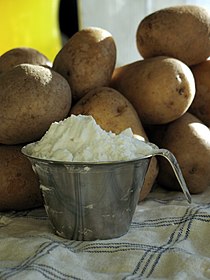
Back نشا البطاطا Arabic Fècula de patata Catalan Kartoffelmel Danish Kartoffelstärke German Almidón de papa Spanish Kartulitärklis Estonian نشاسته سیبزمینی Persian Perunajauho Finnish Fécule de pomme de terre French Tepung kentang ID

Potato starch is starch extracted from potatoes. The cells of the root tubers of the potato plant contain leucoplasts (starch grains). To extract the starch, the potatoes are crushed, and the starch grains are released from the destroyed cells. The starch is then left to settle out of solution or separated by hydrocyclones, then dried to powder.
Potato starch contains typical large oval spherical granules ranging in size from 5 to 100 μm. Potato starch is a refined starch, containing minimal protein or fat. This gives the powder a clear white colour, and the cooked starch typical characteristics of neutral taste, good clarity, high binding strength, long texture, and minimal tendency to foaming or yellowing of the solution.
Potato starch contains approximately 800 ppm phosphate bound to the starch; this increases the viscosity and gives the solution a slightly anionic character, a low gelatinisation temperature of approximately 60 °C (140 °F),[1] and high swelling power.
These properties are used in food and technical applications.[2]
- ^ Shiotsubo, Toshiko (1983). "Starch Gelatinization at Different Temperatures as Measured by Enzymic Digestion Method". Agric. Biol. Chem. 47 (11): 2421–25. Archived from the original on 2018-10-03. Retrieved 2013-03-19.
- ^ BeMiller, James N.; Whistler, Roy Lester (2009). "Potato Starch: Production, Modifications and Uses". Starch: Chemistry and Technology (3rd ed.). Academic Press. pp. 511–39. ISBN 978-0-12-746275-2. Archived from the original on 2022-02-01. Retrieved 2020-11-07.
© MMXXIII Rich X Search. We shall prevail. All rights reserved. Rich X Search